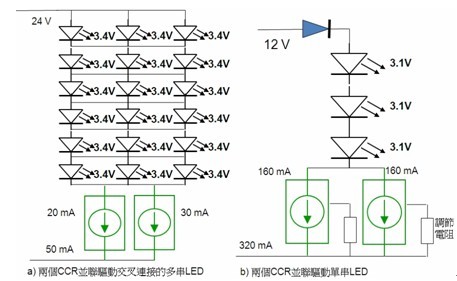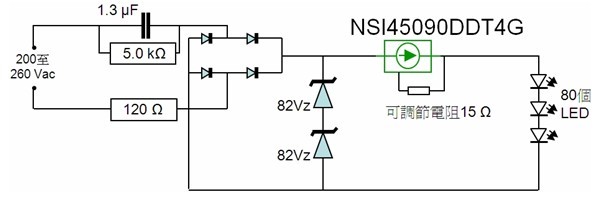Linear LED drivers are the preferred solution for many lighting applications because they are relatively simple, easy to design, and enable LEDs to be driven with precise current regulation regardless of LED forward voltage drop (Vf) or input voltage. . Since the drives are linear, they must match the power dissipation requirements of the application. ON Semiconductor offers a wide range of linear LED driver solutions with currents ranging from 10 mA to 1 A, including the novel Linear Constant Current Regulator (CCR) solution and many other linear driver solutions.
Linear CCR for low current LED drive and application examples
In many low-current LED applications with currents below 350 mA, such as automotive taillights, neon replacement, traffic lights, large display backlights, building lighting and indicators, etc., you can use a common linear regulator or The resistors provide an LED drive solution. Resistors are used to limit the current of the LED string, which is the lowest cost solution, easy to design, and has no electromagnetic compatibility issues. However, when a resistor is used, the LED forward current is determined by the voltage. Under low voltage conditions, the forward current is low, which may result in insufficient LED brightness, and the LED may be damaged under transient conditions such as load dump. The resistance scheme has the lowest energy efficiency and is not conducive to energy saving, which is particularly disadvantageous in applications that emphasize high and low energy consumption. In addition, the resistor scheme also has LED thermal runaway and screening problems. The linear regulator scheme provides better current regulation accuracy (±2%), supports over-power self-regulation, and has no EMI issues. This solution is less energy efficient and cost effective.
Customers need a drive that is more economical than ordinary linear regulators but has a much higher performance than resistors. Using its patented self-biasing transistor (SBT) technology, ON Semiconductor has introduced a novel LED driver solution, the NSI45 Series Linear Constant Current Regulator (CCR), combined with its superior process control capabilities. Compared to resistors, linear CCRs have a constant brightness over a wide voltage range, protecting the LED from overdrive at high input voltages and providing higher brightness at low input voltages. Thanks to its constant current characteristics, customers can reduce or eliminate the coding costs of different LEDs from different suppliers and reduce the total system cost. CCR also has no EMI problems, is packaged in high power density, and is certified by the automotive industry AEC-Q101.
ON Semiconductor's CCR consists of two types of dual-ended fixed output and three-terminal adjustable output. The current ratings range from 10 to 350 mA and 20 to 160 mA, respectively. The maximum anode-cathode voltage VAK is 50 V and 45 V, respectively. High VAK voltage helps to suppress surges and protect LEDs. This series of CCRs has no voltage offset before current flow, and its fast on/off characteristics provide a wide range and precise pulse width modulation (PWM) dimming capability. There are no "plug and play" components on the market that are the same as CCR. All other components require a minimum voltage of 0.5 V to turn on, and do not turn on immediately like CCR (see Figure 1 left). CCR can provide accurate PWM dimming with an external bipolar junction transistor (BJT) (see Figure 1 right). The typical PWM dimming frequency is 0.1 to 3 kHz. There is no color drift during dimming because the LED is always The best current is turned on.

Figure 1: Comparison of the ICR-Vin curve of a 25 mA CCR versus competing components (left); CCR dimming application example (right).
The CCR has a negative temperature coefficient (NTC) function that protects the LED from thermal runaway at extreme voltages and operating temperatures. CCR is easy to design and is suitable for high-side and low-side applications (see Figure 2a). It requires no external components and is very simple for a wider range of applications. In comparison, some suppliers offer Similar functionality or performance as ON Semiconductor CCR, but requires additional external components, cannot be configured for high-end or low-end drivers, has different packages, or has poor thermal reliability.

Figure 2: CCR can be used flexibly for high-end or low-end drives, as well as driving multiple strings of LEDs
The CCR can also be used to drive multiple strings of LEDs (see Figures 2b and 2c), which can be used for both high and low ends. Figure 2b shows an application example of a single CCR driving multiple strings of LEDs. The cost of this configuration is the lowest, but the forward voltage drop of different LEDs must match, and the current of other strings of LEDs increases when a string of LEDs fails, increasing the risk of failure. . More power is dissipated in this configuration in a single CCR package. Figure 2c shows multiple CCR-driven multi-string LEDs. This configuration has the best protection performance, no need to match LEDs, a string of LED faults has no effect on other strings, and power is dissipated in multiple CCR packages.
In addition to driving a single or multiple strings of LEDs with a single CCR, multiple CCRs can be connected in parallel to provide more current, driving single or multiple strings of LEDs. Among them, the use of three-terminal adjustable output CCR helps to meet specific current setting requirements, and the adjustable resistance energy consumption is less than 150 mW.

Figure 3: Parallel multiple CCRs provide more current, driving single or multiple strings of LEDs
CCR can be used in applications powered directly from AC power. After the AC mains input is bridge rectified, it is only necessary to ensure that the input voltage minus the total voltage of the LED string does not exceed the VCR of the CCR. CCR can also be used in T8 fluorescent tube LED replacement applications. The use of CCR to drive LED T8 lamps (see Figure 4) has lower input power, higher power factor, lower total chopping distortion, and higher light output than fluorescent lamps with electronic ballasts.

Figure 4: Circuit diagram of the NSI45090DDT4G CCR in driving LED T8 lamps
ON Semiconductor's NSI45 Series CCRs are available in fixed output versions of 10, 15, 20, 25 or 30 mA, adjustable output versions from 60 to 160 mA, and 20 to 160 mA adjustable output versions certified to automotive standards. ON Semiconductor also offers CCR sample kits and evaluation boards for customers to apply for trials.